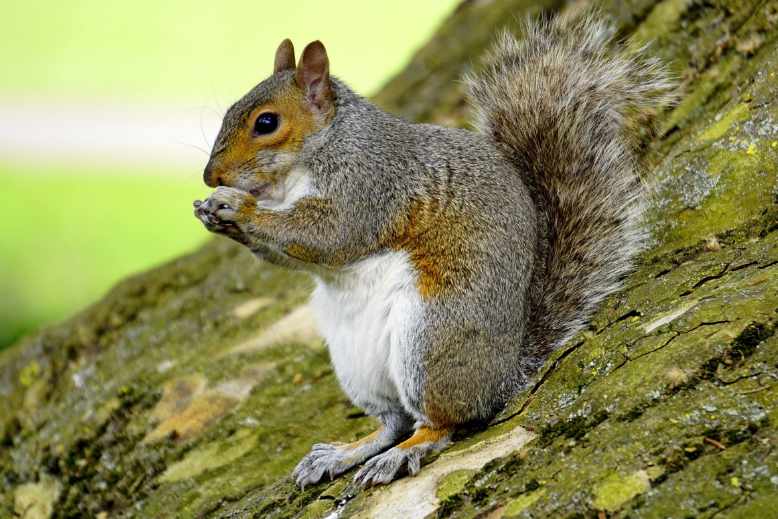
Red vs gray squirrel. Red squirrels can be distinguished from their grey counterparts in multiple ways. The first and most obvious distinction is their size. Red squirrels are roughly half the size of grey squirrels. They are smaller but more aggressive species. Red ones are also famous for having tufts on their ears. These tufts are prominent during the winter season and may disappear in summer. Gray squirrels don’t have any ear tufts.
You might be surprised to know, but fur color isn’t a reliable distinction. Both species are famous for having a variation in their coat. Red squirrels are often seen having a rusty red to dark color coat. Grey squirrels can also have near-to-red fur.
With an almost identical coat, it can be hard to distinguish between red and grey squirrels. So in this article, we will look at the red vs gray squirrel features to understand the major differences between these fluffy species.
Stick around to learn more.
Red Vs grey squirrel: Physical Differences
Here are some of the most prominent differences between the two species:
- Red squirrel appearance

Tamiasciurus hudsonicus, pine squirrel, chickaree, or the famous “red squirrel” is a tinny and adorable mammal with a chestnut-colored upper body and noticeable ear tufts. This tree squirrel has a blond-to-cream underside and a fluffier tail. The coat color of this smallest tree squirrel ranges from bright red to rusty red. Black and almost grey fur colors aren’t unusual as well.
Red squirrels shed their fur at least two times a year. Their summer coats are thinner and have a reddish-brown shade. Winter coats are a bit thicker and darker. It is also common for red squirrels to take on a slightly greyish look during cold times.
The red bushy tail with a hint of a white outline is the most noticeable feature of this tree squirrel. Red squirrels are famous for having thick white rings around their black eyes. These squirrels are also smaller in size.
- Gray Squirrel appearance

Unlike the red squirrels, this grey fur species isn’t native to the UK. They were introduced from North America to the UK in the late 19th century. But now, the grey squirrel is widespread and has become a dominant species.
Grey squirrels can be further divided into two species, Eastern grey squirrel and Western grey squirrel. Both species differ in size and coloring.
Eastern grey squirrels are medium-sized squirrels measuring around 10 and a half inches. Their black, brown, white, and white-tipped fur creates a variable grey effect. Just like red squirrels, Eastern grey squirrels can also change their fur color seasonally. Their grayish-looking coat can give a yellowish-brown shade in the summer.
The underparts of these fluffy squirrels are creamy white. Their bushy tail, sometimes, displays a reddish shade. Both male and female Eastern squirrels are of equal size. They also share the same fur color.
Western Grey squirrel’s coat displays a true shade of grey. Their fur can have a mixture of dark, light, or pure grey colors. These big-sized squirrels have white underparts. They also have a long white-edged bushy tail which helps them to maintain their balance while jumping around. Western grey squirrels have noticeably large limbs.
Grey squirrels are bigger than their red cousins. Plus, they don’t have ear tufts. Their long bushy tail, absence of ear tufts, and considerably big size are enough to separate them from the red squirrels.
- Ear tufts

Unlike grey squirrels, red squirrels do have ear tufts. These tufts are most prominent during the cold seasons.
- Size

Size is the key factor that significantly distinguishes a red squirrel from a grey one. Grey squirrels are generally much bigger and stockier than their red counterparts. Their body can reach the length of 24 to 29 cm, where the tail lengths are anywhere between 19 to 24 cm. Greys can also weigh up to 400 to 650 grams.
It is worth noting that if a good supply of food is available, grey squirrels can breed during the cold times as well. Therefore, it is not uncommon to spot a small-sized grey squirrel hopping in the snow. Just look for the halo effect, ear tufts, and eye-ring, and you won’t confuse a baby grey squirrel with a red squirrel.
Red squirrels have a body length of around 18 to 24 cm. Their tail is not as bushy as other tree squirrel’s tails but has a length of approximately 17 to 18 cm. These rodents are not as heavy as the grey ones and weigh between 270 to 360 grams.
- Tail

You can easily tell the difference between red and grey squirrels by carefully looking at their tails.
- Grey squirrel’s tail is usually made up of different bands of colors.
- Each individual hair on a grey squirrel’s tail has a white tip. When combined, these tips create a white halo effect around the fluffy tail which is visible even in low lights.
- There is no halo effect on a red squirrel’s tail because their tail has only one color, and hairs are not banded like their grey family members.
Red vs gray squirrel: Life Expectancy
Red squirrels are small feisty creatures having an average life expectancy of around 3-6 years in the wild. Some of them may live for 10 or more years.
The average lifespan of a grey squirrel is closer to 6 years. It is surprising to know that the maximum recorded lifespan of a grey squirrel is 12 years in the wild and less or more than 20 years in captivity.
Red vs gray squirrel: Native Range and population
Red furballs are native to the British islands, while grey squirrels are non-native species.
- Red squirrel native range and population

American red squirrels can be spotted throughout the US. Squirrel enthusiasts can find them in the Rocky Mountains, forests of Alaska, and on the east coast of north Georgia.
These adorable rodents like coniferous forests. They also habitat in the broad-leaved woods of southern and western Europe. Red squirrels usually prefer a habitat where they can have easy access to better food sources. Their most favorite habitats are woodlands, grasslands, tundra region, scrublands, and mixed forest.
Siberia, northwest China, and Mongolia are also amongst their native ranges.
The population of red squirrels is less than 287000 squirrels in the entire United Kingdom.
Red squirrels are classified as near threatened in Northern Ireland, Wales, and England.
- Grey squirrel native range and population

Grey squirrels are native to Eastern North America and Midwest America. The Eastern Gray squirrel species ranges from Texas to Florida and from New Brunswick to Manitoba. These rodents prefer to habitat in temperature coniferous forests, tropical savannas, temperature grasslands, and flooded grasslands.
Western grey squirrels typically prefer living in woodlands and coniferous forests. Their population extends across the Northern edges of California, the United States’ West Pacific region, Washington State, and northern Mexico.
The estimated population of grey squirrels is around 2.7 million in the United Kingdom.
Grey squirrels are classified as “invasive” and “non-native” species in the United Kingdom. They are also listed as” invasive alien species” in Europe.
Red vs gray squirrel: Diet
Red Squirrels love to munch hazelnuts. Their diet primarily consists of nuts, but they can also feed on seeds, young shoots, beech, berries, sapwood, and chestnuts. They are vegetarian but can consume bird eggs and hatchlings. Red squirrels do not hibernate and like to stay active throughout the season. They survive the cold months by eating fungi.
The eating habits of both red squirrels vs grey squirrels are almost identical. Eastern grey squirrels prefer eating seeds, flowers of 24 kinds of oak trees, nuts, and buds. They also devour insects in the summer. Their winter diet mainly revolves around wheat, corn, and other cold-season crops. Some of these rodents don’t feel shy eating young squirrels.
Western grey squirrels mainly feed on pine cone seeds. Their favorite snacks include various insects, berries, sap, fungus, and bark.
Red squirrel vs gray squirrel: Reproduction
Red squirrels usually reproduce twice a year. February to April and May to June are their two mating seasons.
- Some female red squirrels mate with different males.
- The gestation period of a female red squirrel is between 36 to 40 days.
- Each litter consists of 3-5 babies, which are called kittens.
- Babies don’t open their eyes until they are 27 days old. It takes them around 7 weeks to become fully independent and 9 to 11 weeks to establish their own territory. Till then, young ones are looked after by the mother red squirrels.
- Besides the mating season, red squirrels like to live alone. They do not form any groups but can enter into a female’s territory for mating purposes.
- Males don’t stick around to raise the baby squirrels.
Male Eastern Grey squirrels compete with each other to mate with a female.
- Females of this species can also mate with more than one squirrel.
- The incubation period lasts for 40 to 44 days.
- Females usually give birth to 2-3 squirrels.
- The first mating season lasts from December to February, while the second season lasts from May to June.
- Male grey squirrels take around 11 months to reach sexual maturity. Females are sexually mature when they are 15 months old.
The mating season of Western grey squirrel usually occurs in early winter and lasts till late spring.
- They produce 3-5 young ones per litter.
- The gestation period of female western grey squirrels lasts around 45 days.
- Young ones are weaned when they are 10 weeks old.
- Western grey squirrels can fight and injure each other during the mating season.
- Mother Western grey squirrels display high territorial behaviors. They don’t allow others to enter their territory and don’t mind getting into fights.
Frequently Asked Question
Do red squirrels, and grey squirrels get along?
Unfortunately, the answer is a big No.
Red and grey squirrels cannot live together. Greys are known for carrying a virus called Squirrelpox (SQPV). Apparently, this virus has no effect on the health of grey squirrels but can leave a deadly impact on red squirrels. Once infected, red squirrels die of dehydration or starvation.
Grey squirrels are considerably larger and sturdier than reds. They can compete more successfully for habitat, food, and water sources. Greys are also likely to feed on green acorns, which reduces the feeding options for red squirrels as they cannot digest mature acorns and only eat green acorns.
Can red and grey squirrels interbreed?
No. They do not.
Both red and grey squirrels belong to different species. These species usually don’t share the same territory or habitat. They aren’t reproductively compatible and prefer not to interbreed.
Are red squirrels aggressive?
American red squirrels are notorious for their aggressive tendencies. This small animal is surprisingly territorial and aggressive. Red squirrels have a mighty attitude, and they don’t tolerate any other squirrel in their territory. They are also very noisy.
These feisty squirrels are bold and curious. They don’t shy away from human proximity, especially when there is food around. Red squirrels are not afraid of their larger counterpart. You may even find a red squirrel chasing a grey one out of its territory. These little critters are also voracious eaters. Though both species are busy bees, red squirrels are more active.
Are grey squirrels aggressive?
Grey squirrels aren’t usually aggressive. Some females may show aggressive behaviors while nesting, but other than that, this species isn’t territorial. Grey squirrels aren’t as bold as red ones.
Which squirrel is smarter?
When it comes to food, grey squirrels are considered better problem solvers. They are actually more intelligent, and their survival instincts are way stronger than their aggressive cousins.
Are red squirrels endangered?
Red squirrels have been endangered since the day their grey cousins were introduced in the United Kingdom. Though their worldwide population is not known, their species have decreased drastically. The primary threat to their species is food competition, grey squirrel infestation, habitat loss, overhunting, accidents, and pet trade.
Wrapping up:
While distinguishing between the red and grey squirrels is quite a challenge to the untrained eye, it is not impossible. Follow our guidelines and soon you will be able to spot the differences.
Peace!
